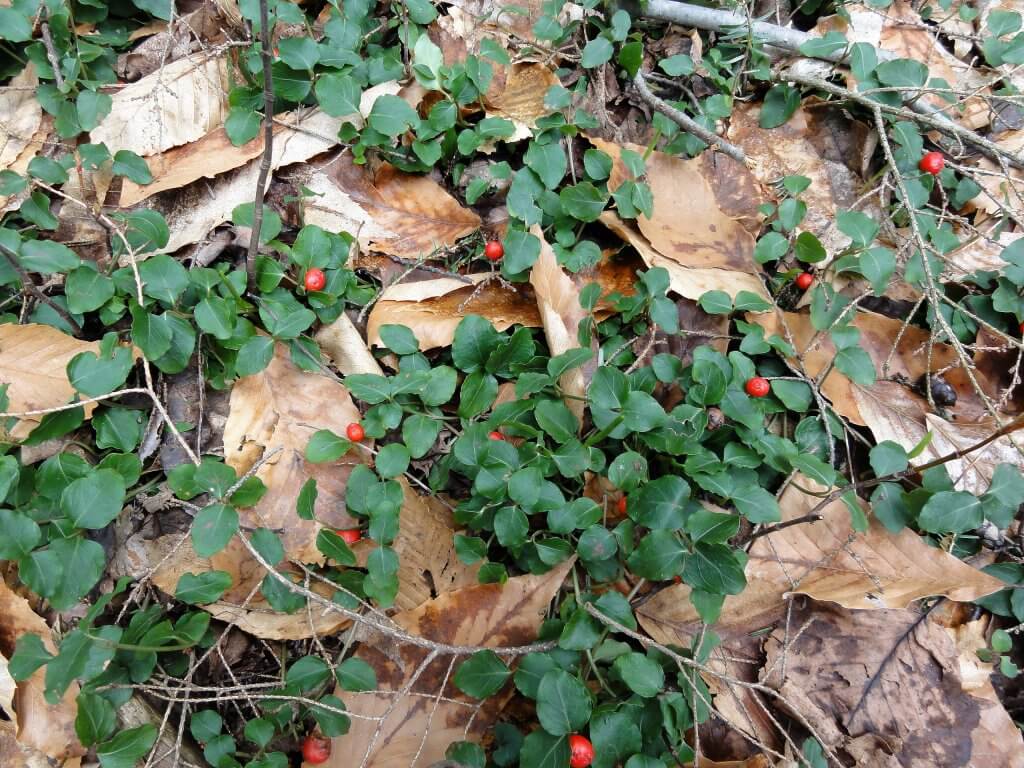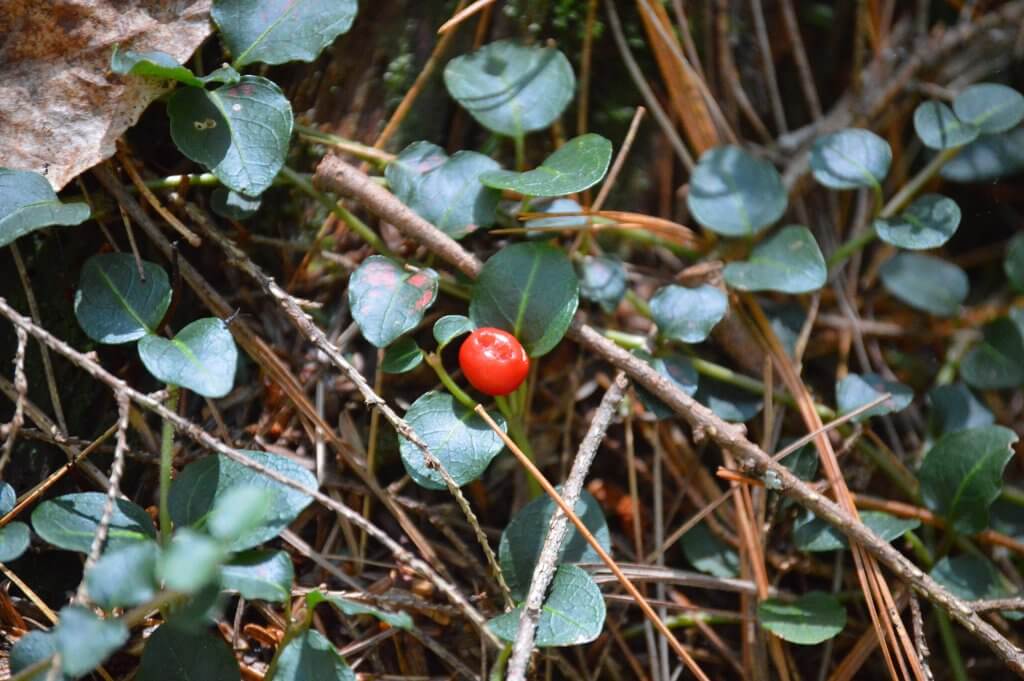Partridge Berry (Mitchella repens), is a low growing, evergreen vine that trails along forest and woodland floors. It is native to North America, particularly the northeastern states, and areas of Southern Canada. It is frequently grown as an ornamental in other countries, and can often escape cultivation and enter the wild. A food source for Native Americans and settlers alike, it has gained a number of common names throughout its history. From squaw vine and running fox, to twin berry and Noon die oo nah yeah, which is the Mohawk name.
As a trailing vine, the plant often forms carpet coverage along forest edges, particularly near the banks of streams and rivers where it thrives in the moist soil. You’ll typically find them growing no more than 10cm tall.

The stems are rather woody when mature, and feature pairs of simple, oval leaves that sit opposite one another. A great identifying characteristic is the veining that runs through the leaves. These veins tend to be a very pale green in comparison to the deep green of the leaves.
The flowers are trumpet shaped and pale pink to white and have a fine coating of hairs on the upper side. They appear in pairs at the end of each woody stem, both sharing an ovary which will produce one berry. Partridge berries, or to use their official term ‘drupes’, are bright red and shiny, and each harbours up to 8 seeds. When the drupes have formed you can see two darker red marks that hint at the past presence of the two flowers.
Edible parts and other uses
Partridge berry fruits are perfectly edible with a tart flavor quite similar to cranberries. They can be substituted into any recipe that calls for berries, from muffins to jams, and even sauces and salads. Like cranberries, partridge berries work well with very rich foods, from cheeses to game meats.
Past evidence suggests that partridge berry was once used to induce pregnant women. Studies have concluded that it may in fact contain compounds that encourage abortion. Partridge berry is under studied, so pregnant women should avoid the berry to avoid any serious complications.

Cautions
Because of the abortifacient compounds that partridge berry may contain, pregnant women should not consume the berry.
As a wild red berry, careful identification is essential when foraging partridge berry. It does not currently have any close lookalikes, but extra care is still needed before eating any wild plant.
Foraging
Look for them in areas alongside rivers, or in forests that cover bottomland, you can generally find them where moisture and shade will be high. They tend to carpet fairly wide areas, also forming colonies so you are likely to have a good chance of finding a good few berries.
Partridge berries are usually ripe for picking between mid summer and mid fall. Depending on your location and the weather, it may be worth a few trips to your local spot to check their development. A number of berries can stay present on the plant until early spring, however with grouse and small mammals favoring the berries, there may not be many left to forage.
The berries really are a treat, as the plants rarely produce an abundant crop. Although not endangered, make sure to leave a few berries behind, for other foragers (human or animal!), and to allow the plant to take seed again.

Did you know…
The signature red berries and dark, evergreen green leaves made partridge berry a popular choice for Christmas arrangements and decorations.
Conclusion
Often chosen as an ornamental plant for a shady garden corner, partridge berry is re-emerging as a foraging favorite too. A nutritious, trailside treat to forage whilst out in the wild, they are relatively high in antioxidants and vitamin C. It would make a wonderful plant to grow and forage from your own back yard.
—————Written by Hannah Sweet
Hannah is a freelance writer and graphic designer from the UK. With a penchant for travelling, photography and all things botanical, she enjoys writing about a wealth of topics and issues, from conservation and slow living, to design and travel. Learn more about her writing and design services at www.sweetmeanders.co
Many of our readers find that subscribing to Eat The Planet is the best way to make sure they don't miss any of our valuable information about wild edibles.
See our privacy policy for more information about ads on this site







One Response
I was out walking in a woods in Ohio where partridge berry grows pretty abundantly.
You mentioned in this article that there isn’t anything that looks like it, but I found teaberry (the same one they flavored teaberry gum with) growing right next to it. The good news is they are also edible